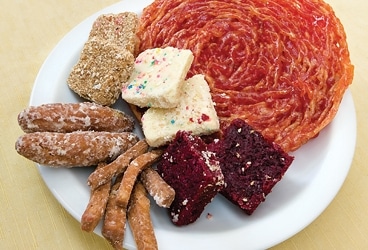Taste: The Sweetest Memories
"Just eat it," my father says, watching me as I gingerly nibble the little orange ball. He shakes his head. It is 1979, and I am 11 years old. We have come from a Hindu prayer meeting in his hometown of Chaguanas, Trinidad, site of the now-famous Hindu celebration of Diwali Nagar. I am sweating in my stiff sundress with the crinoline skirt that every- one has admired; my brother is equally turned out in a suit, a testament to my father's success in America. I shuffle behind my father in the blistering-hot street as I pick suspiciously at the sweet treat.
The ball is firm and sticky, with just enough sugar, and some taste I can't identify — something minty and familiar. Later I'll learn the spice is cardamom. But for now, a new world has opened up to me, a world of mithai, the Hindu name for sweets. Made from local sugar cane, they are served up in prodigious quantities every Diwali in late October or early November.
Returning to Trinidad now as a chef, I find myself in my ancestral homeland once again, on the eve of what was once my Trinidadian father's favorite holiday. Before I leave, I must satisfy my craving for mithai, for sugar is what largely informs our palates here on this island. But could those childhood memories of sugary treats and holiday-inspired generosity be as sweet for me today?
It is an inextricable part of our Indian heritage — my father's and mine. My great grandfather, like so many other Indians, arrived here in the 19th century to labor in the cane fields. The white gold they mined was largely bound for England and America, but come Diwali, the precious stuff was plentiful in Indian homes.
Though I can find the pastries anywhere, I am bound for Débé, a once sleepy backwater where residents have earned a reputation as master mithai makers. To feed a once-thriving sugar economy, over the years Débé locals set up small stands selling traditional pastries, cookies and sweets as well as "doubles," sandwiches of spicy chickpeas and fried dough. It is a city built upon the fortunes of sugar.
My sentimental sweet tooth sends me on nearly a full day's travel into southwestern Trinidad, where Débé lies not far from Icacos Point, about seven miles from Venezuela. Though the day is rainy, cars throng the highway. Like me, these people know the goodies in Débé will be piled high because Diwali is coming.
This is our best chance to taste the threefold holiday: at once a devotion to Lakshmi, goddess of prosperity; the New Year; and the triumph of good over evil. While he was growing up, my father waited eagerly for Diwali, when fellow Hindus gave trays of mithai away, and there was no shame in taking them. It was a Hindu rite rather than an act of charity, a respite from the desperate poverty in which he was raised. Even as an adult, the thought of it left him longing for his tropical home as the leaves outside our window raged in a blast of orange and red against the sooty New York City sky.
Turning off the highway toward the center of Débé, I see Diwali preparations have started. Towers of diyas, traditional clay lamps, are stacked in the yards, waiting to be filled with coconut oil and placed on elaborate displays. The displays were simpler in my father's time, but he loved them nonetheless.
"The diyas were so pretty, burning on the steps of the houses, in the balconies or along the roadside," he used to say, smiling, holding his hand up, forming a little cup with his fingers. "They were like little stars in the pitch black night."
I get out of my car and find a vendor whose small table is piled high with an assortment of mithai in gallon jars with tightly fitted lids. There are golab jamun (mahogany-colored balls of fried cottage cheese doused in sugar syrup) and ladoo (deep-yellow orbs of toasted chickpea flour, sweetened and essenced with cardamom). Barfi squares — made from coconut flakes, pistachio or almond, sugar spices and milk — are stacked like so many pretty tiles in alternating colors of pink, orange and light green.
All are virtually unchanged from the original Indian recipes brought from India by our ancestors more than 150 years ago. They're balanced with the Trini creations I find here, too, like kulma and chip chip: dough sticks and coconut sugar cakes.
I buy jalebi first, a fritter of yeasty dough swirled through hot oil, fried crisp then dipped in sugar syrup. My father made these for us, and we'd gobble them while they were too hot, burning our fingers and tongues. This time, though, I nibble a jalebi ever so delicately. It is still crisp under the wash of mouth-puckering sugar syrup, and I close my eyes to savor the heady taste that carries me back through years of Diwali celebrations.
When I open them again, I see a little boy of 10 or 11. He is barefoot and his T-shirt dirty. He's toting bags of sour plums as he weaves through the crowd. "Plums, salt plums!" he calls out, largely ignored, trying to compete with established pastry-mongers for their sweet-toothed clientele.
I beckon him over, and the child smiles. I buy some plums and tell him to keep the change, which he carefully puts in his pocket. He walks on, the bag hoisted on his shoulder, his knees knobby on thin legs, his thick, black hair standing up away from his head — so similar to my father's childhood photo. I imagine the boy taking the money he just earned to buy himself a jalebi or golab jamun, the sticky syrup making his fingers tacky and coating his tongue as he relishes the taste of a treat well-earned.
